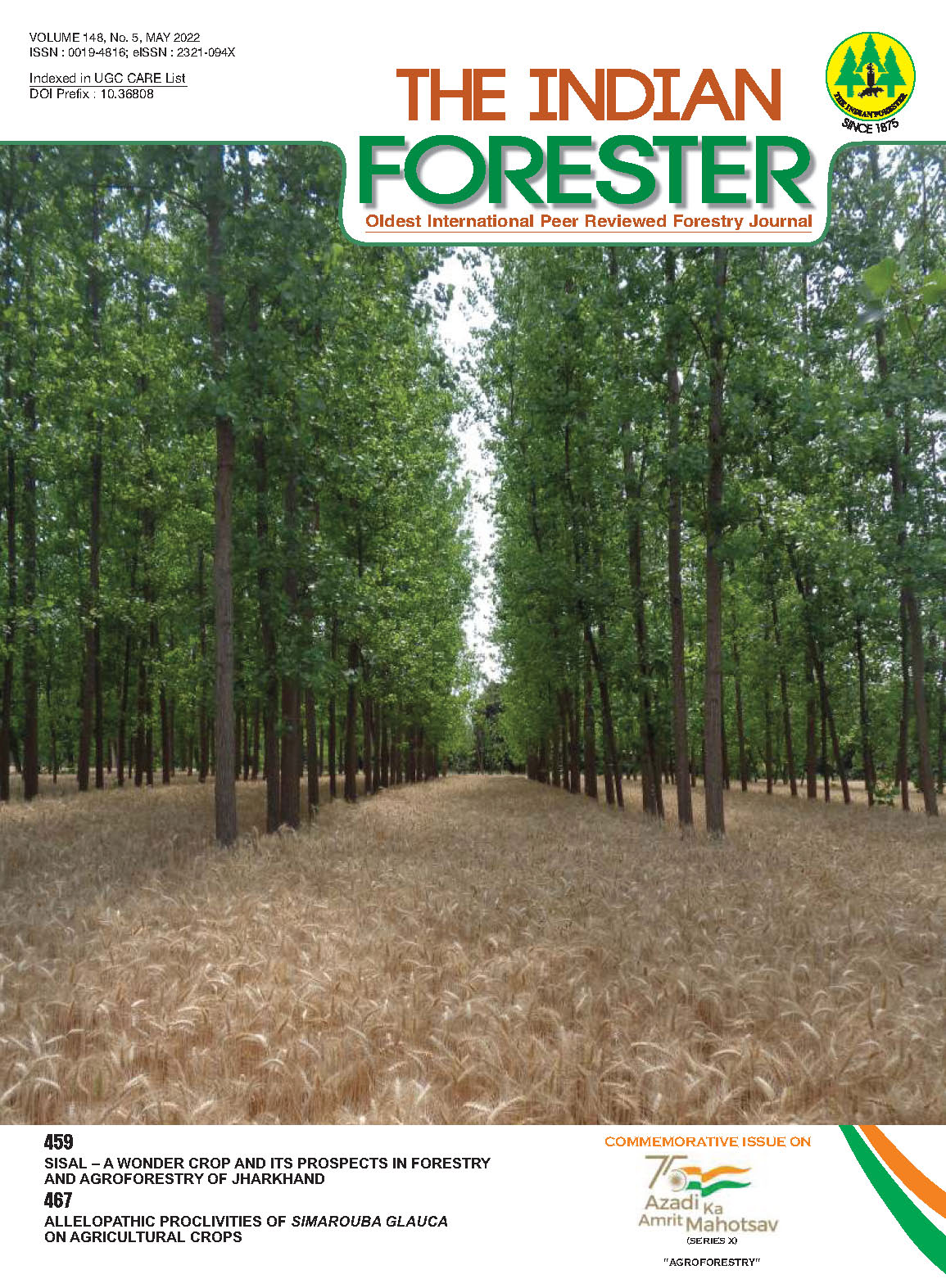Performance of Poplar Plantation under different levels of Nutrients in an Agroforestry System
DOI:
https://doi.org/10.36808/if/2022/v148i5/166952Keywords:
Growth parameters, Net returns, Nutrient requirement, Nutrient status, Poplar.Abstract
Poplar (Populus deltoides Bartr.) has been adopted in agroforestry systems by farmers of north-western India owing to its fast growth. An experiment was conducted to standardize the nutrient requirement of poplar plantation during 6 years of growth for getting its better productivity. The treatments consisted of nine combinations (T2to T10) of N and P (as P2O5) in addition to an uncropped control (T1) of poplar plants. Every year, whole of P and 1/3rd N was applied during May after harvesting of wheat, 1/3rdN in July and the remaining 1/3rd N in September. The height and diameter at breast height (DBH) of plants were measured every year in the month of January and timber weight was calculated from these parameters. The DBH, height and timber weight of poplar plantation were lowest in uncropped control (19.01 cm, 17.56 m and 310 q/acre, respectively) and highest (21.46 cm, 20.10 m and 449 q/acre, respectively) with the application of N and P (as P2O5) @ N100P40, N150P80, N200P120, N250P160, N300P200 and N350P240g/plant (T6) during 1st, 2nd, 3rd, 4th, 5th and 6th year, respectively. However, the application of P during 4th, 5th and 6th year did not increase the timber weight over N application alone. The grain yield of wheat and fodder yield of pearlmillet decreased with increase in age of plantation. Net returns from the agroforestry system (crops and trees) were highest in T5 which were Rs. 408791 per acre Soil OC and available N and 6 . P were lowest in uncropped control (T1) and highest in T10 (tenth treatment) i.e., with the application of N and P @ N N150P80, N200P120, N250P160, N300P200,N350P240 and N400P280 g/plant during 1st, 2nd, 3rd, 4th, 5th and 6th year, respectively. Therefore, treatment T was better than other treatments for getting higher productivity 6 and better returns from poplar plantation.References
Albaugh T.J., Rubilar R., Fox T., Allen H.L., Urrego J.B., Zapata M. and Stape J. (2015). Response of Eucalyptus grandis in Colombia to mid-rotation fertilization is dependent on site and rate but not frequency of application. For Ecol Manage, 350: 30-39.
Brar J.S. (1998). Fertility status of soils of Punjab and contribution of groundwater towards plant nutrition. In: M.S.
Brar and S.K. Bansal (eds) Balanced Fertilization in Punjab Agriculture. PAU, Ludhiana. pp. 10-19.
Dhiman R.C. and Gandhi J.N. (2017). Comparative performance of poplar, Melia and eucalyptus-based agroforestry systems. Indian J. Agrofor., 19(2): 1-7.
Fang T., Young W., Luo J. and Gao Y. (2005). Long term fertilizer and water availability effect on cereal yield and soil chemical properties in North West China. J. Soil Sci. Soc. America, 69: 842-855.
Gill R.I.S., Singh B., Kaur N. and Luna R.K. (2007). Evaluation of crops in poplar plantation with three spacing in two row directions. Indian Forester, 133(2a): 45-57.
Henderson D.E. and Jose S. (2010). Biomass production potential of three short rotation woody crop species under varying nitrogen and water availability. Agrofor Syst., 80: 259-273.
Jackson M.L. (1973). Soil Chemical Analysis. Prentice Hall of India Pvt. Ltd., New Delhi.
Jain S.K. and Singh P. (2000). Economic analysis of industrial agroforestry: poplar (Populus deltoides) in Uttar Pradesh (India). Agrofor. Syst., 49: 255-273.
Khullar V., Gill R.I.S., Singh B. and Kaur N. (2010). Economic evaluation of poplar (Populus deltoides) based forestry and agroforestry models in Punjab, India. Indian J. Social Res., 51: 51-67.
Kumari T.K., Sreenivasulu A., Meru E. and Rao P.S. (2002). Response of chemical fertilizers on Eucalyptus tereticornis clones. Indian Forester, 128: 502-508.
Newman S.M., Bennett K. and Wu Y. (1998). Performance of maize, beans and ginger as intercrops in Paulownia plantations in China. Agrofor. Syst., 39: 23-30.
Panse V.G. and Sukhatme P.V. (1985). Statistical Methods for Agricultural Workers. ICAR, New Delhi.
Shukla J.K. and Kasera P.K. (2004). Response of irrigation and spacing levels on growth parameters of khejri (Prosopis cineraria). Indian J. For., 27: 335-338.
Singh B. (2001). Influence of fertilization and spacing on growth and nutrient uptake in poplar (Populus deltoides) nursery. Indian Forester, 127: 111-114.
Singh B., Gill R.I.S. and Kaur N. (2009). Deficiency of zinc in poplar nursery and plantations in Punjab and its amelioration. Indian Forester., 135: 78-83.
Singh B., Gill R.I.S. and Kaur N. (2018). Effect of different levels of nutrients on growth and productivity of clonal eucalyptus. Indian J. Agrofor., 20: 73-76.
Singh B. and Sharma K.N. (2007). Tree growth and nutrient status of soil in a poplar (Populus deltoides Bartr.)-based agroforestry system in Punjab, India. Agrofor. Syst., 70: 125-134.
Singh B., Singh P. and Gill R.I.S. (2016). Seasonal variation in biomass and nitrogen content of fine roots of bead tree (Melia azedarach) under different nutrient levels in an agroforestry system. Range Manage Agrofor., 37: 192-200.
Singh H.S. (1988). Comparative economics of trees and crop production in Haryana. Indian J. Agri. Econ., 43: 289-295.
White P.J., George T.S., Hammond J.P. and James E.K. (2014). Improving crop mineral nutrition. Plant Soil, 384: 1-5.
Yin C., Pang X. and Chen K. (2009). The effects of water, nutrient availability and their interaction on the growth, morphology and physiology of two poplar species. Env. Exp. Botany, 67: 196-203.
Downloads
Downloads
Published
How to Cite
Issue
Section
License
Unless otherwise stated, copyright or similar rights in all materials presented on the site, including graphical images, are owned by Indian Forester.





